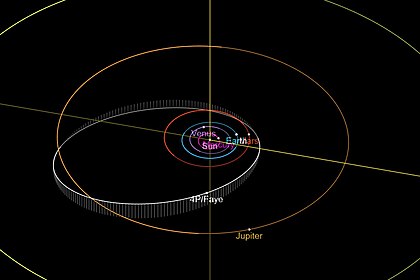astro.wikisort.org - Comet
Comet 4P/Faye (also known as Faye's Comet or Comet Faye) is a periodic Jupiter-family comet discovered in November 1843 by Hervé Faye at the Royal Observatory in Paris. Its most recent perihelia (closest approaches to the Sun) were on November 15, 2006; May 29, 2014;[4] and September 8, 2021.[1]
 | |
| Discovery | |
|---|---|
| Discovered by | Hervé Faye |
| Discovery date | November 23, 1843 |
| Alternative designations | P/1843 W1, P/1850 W1, 1910e |
| Orbital characteristics A | |
| Epoch | 2021-09-23[1] (JD 2459480.5) |
| Aphelion | 6.03 AU[1] |
| Perihelion | 1.619 AU |
| Semi-major axis | 3.824 AU |
| Eccentricity | 0.5767 |
| Orbital period | 7.48 a |
| Inclination | 8.013° |
| TJupiter | 2.737 |
| Earth MOID | 0.56 AU (84 million km) |
| Dimensions | 3.54 km[2] |
| Last perihelion | 2021-Sep-08[1] May 29, 2014 November 15, 2006 |
| Next perihelion | 2029-Mar-09[3] (JPL Horizons) |
The comet was first observed by Faye on November 23, but bad weather prevented its confirmation until the 25th.[5] It was so faint that it had already passed perihelion about a month before its discovery, and only a close pass by the Earth had made it bright enough for discovery. Otto Wilhelm von Struve reported that the comet was visible to the naked eye at the end of November.[5] It remained visible for smaller telescopes until January 10, 1844, and was finally lost to larger telescopes on April 10, 1844.[5]
In 1844, Friedrich Wilhelm Argelander[6] and Thomas James Henderson[7] independently computed that the comet was a short-period comet; by May, its period had been calculated to be 7.43 years.[5] Urbain Le Verrier computed the positions for the 1851 apparition, predicting perihelion in April 1851.[5] The comet was found close to his predicted position on November 29, 1850, by James Challis.[5]
The comet was missed during its apparitions in 1903 and 1918 due to unfavorable observing circumstances.[5] It reached a brightness of about 9th magnitude in 2006.[8]
4P/Faye has a close approach to Jupiter every 59.3 years, which is gradually reducing its perihelion and increasing its orbital eccentricity. In the most recent close approach to Jupiter (March 2018), Faye's perihelion changed from about 1.7 AU to about 1.5 AU.[9]
The comet is estimated to be about 3.5 km in diameter.[2]
- Orbit of Comet 4P/Faye.
References
- "4P/Faye Orbit". Minor Planet Center. Retrieved 2014-06-16.
- "JPL Small-Body Database Browser: 4P/Faye" (last observation: 2014-01-29 last obs). Jet Propulsion Laboratory. Retrieved 2014-10-29.
- "Horizons Batch for 4P/Faye (90000117) on 2029-Mar-09" (Perihelion occurs when rdot flips from negative to positive). JPL Horizons. Retrieved 2022-06-15. (JPL#K212/23 Soln.date: 2022-Jun-08)
- Syuichi Nakano (2011-11-01). "4P/Faye (NK 2145)". OAA Computing and Minor Planet Sections. Retrieved 2012-02-18.
- Kronk, Gary W. (2001–2005). "4P/Faye". Retrieved 2005-12-25. (Cometography Home Page)
- Argelander, Friedrich W.A. (January 3, 1844). "Schreiben des Herrn Professors Argelander, Directors der Sternwarte in Bonn, an den Herausgeber". Astronomische Nachrichten. 21 (495): 225–226. Bibcode:1844AN.....21..225A. doi:10.1002/asna.18440211502.
- Henderson, Thomas J. (January 10, 1844). "On the Orbit of the Comet of Faye". Monthly Notices of the Royal Astronomical Society. 6 (3): 18–20. doi:10.1093/mnras/6.3.18b.
- Seiichi Yoshida (2008-10-12). "4P/Faye (2006)". Seiichi Yoshida's Comet Catalog. Archived from the original on 13 October 2007. Retrieved 2007-09-24.
- "Comet of the month - 4P/Faye | British Astronomical Association".
External links
- Orbital simulation from JPL (Java) / Horizons Ephemeris
- 4P/Faye at CometBase database
- 4P/Faye – Seiichi Yoshida @ aerith.net
- 4P/Faye history from Gary W. Kronk's Cometography
- 4P/Faye at the Minor Planet Center's Database
На других языках
[de] 4P/Faye
4P/Faye ist ein kurzperiodischer Komet, der von Hervé Faye am 22. November 1843 entdeckt wurde.[1][2] Er wurde seitdem bei jeder Wiederkehr bis auf 1903 und 1917 beobachtet.- [en] 4P/Faye
[es] 4P/Faye
4P/Faye (también conocido como cometa Faye) es un cometa periódico descubierto en noviembre de 1843, por Hervé Faye desde el Real Observatorio de París.[ru] 4P/Фая
Комета Фая (4P/Faye) — короткопериодическая комета из семейства Юпитера, которая была открыта 23 ноября 1843 года французским астрономом Эрве Фаем в Парижской обсерватории, вблизи звезды γ Ориона. Она была описана как диффузный объект с чётко выраженным ядром и небольшим хвостом простирающимся на 4 угловых минуты. Комета обладает довольно коротким периодом обращения вокруг Солнца — чуть более 7,52 года.Другой контент может иметь иную лицензию. Перед использованием материалов сайта WikiSort.org внимательно изучите правила лицензирования конкретных элементов наполнения сайта.
WikiSort.org - проект по пересортировке и дополнению контента Википедии


